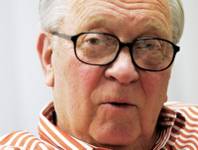Sunday, Feb. 6, 2011 | 2:01 a.m.
Degreed in Nevada
Nevada ranked 41st among the states for its share of adults aged 25 to 44 with bachelor’s degrees, born in the state who still live here (39%). The top 5 Texas (70%) California (66%) Minnesota (62%) Georgia (62%) North Carolina (61%) The bottom 5 Alaska (19%) Wyoming (27%) Vermont (30%) South Dakota (34%) Delaware (36%)
Off to college?
Clark County School District percentage of students requesting transcripts be sent to two- or four-year colleges or universities (some request a transcript be sent to a college or university but never attend): 2006: 73 percent 2007: 74 percent 2008: 73 percent 2009: 71 percent 2010: 69 percent Washoe County School District percentage of graduates who enrolled in two- or four-year colleges or universities: 2008: 54.5 percent 2009: 50.4 percent 2010: 46 percent Sources: Clark County School District; Washoe County School District
Sun coverage

Jim Rogers

Neal Smatresk
Beyond the Sun
Sun archives
- Higher education officials say Sandoval budget cuts a ‘death sentence’ (2-4-2011)
- Education in forefront of upcoming budget battle (1-30-2011)
- Chancellor: University tuition would have to go up 73 percent to cover Sandoval budget gap (1-27-2011)
- School officials warn of jobs cuts, larger classes under proposed budget (1-26-2011)
- A steep climb for Nevadans (1-26-2011)
- Soft words during State of the State hide Nevada in pain (1-25-2011)
- Teachers not pleased with most of Sandoval’s speech (1-25-2011)
- In response, Democrats say taxes might be part of budget solution (1-24-2011)
Eric Glyman is exactly the type of young person Nevada needs to reinvent itself.
The 20-year-old graduate of Green Valley High School was a valedictorian, science olympiad and member of the speech and debate and track and field teams.
Now a junior at Harvard, he’s majoring in Chinese and economics.
And he’s probably not coming back. Opportunities are much better elsewhere.
Nevada, like many states and countries, has always suffered from a flight of human capital, or “brain drain,” as it’s often called. Many of our best and brightest take a pass on UNR and UNLV, and once they matriculate at elite universities elsewhere, they wind up in regions that are financial and technological centers and offer more varied cultural and recreational lives.
This brain drain problem was mitigated during the boom, as tens of thousands of college-degreed Americans came to Nevada for opportunity. The valley was flush with architects, construction management experts, marketers, attorneys, accountants and other professionals. In fact, today there are roughly 191,000 working-age adults in the valley with bachelor’s degrees who weren’t born in Nevada, according to an analysis of census data by Alan Berube of the Brookings Institution.
Although we enjoyed a migration surge of the educated, we also had a massive influx of less educated service and construction workers, and we were left with a workforce that was less educated than most large urban areas — 21 percent of Clark County residents had bachelor’s degrees as of 2009, compared with the national average of 27 percent, according to census data compiled by the Chronicle of Higher Education. By contrast, 28 percent of residents of Maricopa County, where Phoenix sits, have degrees; in Salt Lake County, it’s 29 percent.
This matters because economic development experts agree that Nevada faces a difficult path to recovery. We have limited natural resources, a struggling construction economy that won’t recover anytime soon and over-reliance on a tourism industry that is itself dependent on free-spending outsiders in an age of parsimony.
In short, we need our tourism industry to expand and innovate, or we need new industry. Both options would seem to require college-educated workers whom we don’t currently possess in enough numbers.
This need comes amid a steep budget deficit that will almost certainly mean cuts in higher education. Gov. Brian Sandoval has proposed a decrease of at least 17 percent.
Even without budget cuts, it’s an open question whether we can keep our best here, attract educated outsiders, or take our middling high schoolers and whip them into college shape.
Nevada ranked 41st among the states for its share of adults ages 25 to 44 with bachelor’s degrees, born in the state who still live here. More than three out of five have left.
A few years ago, the state produced about 50 National Merit Scholars, and all but one of them left.
Jim Rogers, former chancellor of the Nevada System of Higher Education, puts it succinctly: “They go away to the best schools, and they never come back.”
In the past two years, our ability to offset those losses with newly arriving educated residents has plummeted. The valley once ranked sixth among the 52 largest metro areas in net in-migration of people with degrees, but now we’re 27th. And as the Great Recession has led to an exodus, the situation would appear to be worsening.
“The bottom line,” says Robert Lang, director of Brookings Mountain West, “is that you’re not going to attract sufficient numbers to make up for the losses.”
UNLV President Neal Smatresk and UNR President Milton Glick seem committed to attracting talented students, using their home-field advantage by keeping Nevada’s best.
“Bright, hardworking students ought to be recruited just as much as people who are 6-feet-10 inches and have soft hands,” Glick quips.
He has begun to repeat the success he had recruiting at Arizona State University, where he increased the number of enrolled National Merit Scholarship winners from three to more than 400. At UNR, the number of National Merit winners has increased from five to 38.
Both he and Smatresk have done this through spotlighting and nurturing talented high school students — UNR has “signing days” like that for athletes. Both institutions have also built programs that guarantee what Glick calls “one-on-one discovery relationships with a distinguished faculty.”
At UNLV, Smatresk touts the honors program, the Global Entrepreneurship Experience program and the Lincy Institute as offering the high-level engagement and financial help that the best students require.
Spencer Norman is a first-year student at UNLV in the entrepreneurship program. He made the dean’s list in his first semester and said he is thrilled by his decision to stay in Nevada. He was accepted at the better-ranked universities of Oregon, Iowa and Colorado, but was enticed by the entrepreneurship program and the financial aid, he says.
Smatresk says getting students is no different from getting the best faculty, or a firm getting the best lawyer. “There’s a marketplace for students. We’re competing against every great school in the country,” he says.
Or as Rogers puts it: “You have to go out and buy the best students.”
The low-hanging fruit, as it were, are Nevada’s best high school students, who can be enticed with the Guinn Millennium Scholarship and other programs. If we can retain them, they will often attract their friends and begin to raise the level of learning for the entire university. That in turn will help us attract better out-of-state students.
“A critical mass of outstanding students changes the quality of education for all our students,” Glick says.
Glick is surely talking about students such as Kathleen Phelan, a star 2008 graduate of Green Valley High School now in the honors program at UNR on a full scholarship. She’s studying international affairs, with a minor in Italian and a semester in Italy. She had to finish her Italian minor quickly because of program cuts. More are coming.
Phelan is considering law school at UNLV, but she says she wants to experience the wider world and sees a UNLV law degree as most useful only if she stays here, which looks unlikely.
She is not unique: Whether our best high schoolers leave or stay in Nevada to go college, many will go out of state to find jobs or go to graduate schools. “Being elsewhere provides an opportunity to interact with other cultures,” she says.
Jim Russell, a geographer who focuses on human capital issues, says we shouldn’t think of the phenomenon of our best students leaving as an entirely bad thing.
In fact, Russell says, we should celebrate the fact that our best high schools produce elite graduates who go on to top universities and get high-paying jobs in New York City and San Francisco.
“If you want to stop brain drain, then don’t educate them. That will certainly root them,” Russell says sarcastically. Chris Briem, a University of Pittsburgh economist, echoes Russell: “Young grads are going to go. Stopping that is tilting against windmills, and it hurts those young people,” he says.
Russell adds: “Show me a low out-migration neighborhood, and I’ll show you a poor neighborhood.”
For instance, think of the poorest Rust Belt inner city neighborhoods or down-on-their-luck rural towns, and what comes to mind? People who are trapped and never leave.
Russell points out that the Denver metro area has huge numbers of its best high school students leave. But we don’t think of Denver as having a brain-drain problem because of its tremendous churn: The loss of those smart people is more than compensated by Colorado’s ability to attract educated workers with high-skill industries and a high-altitude lifestyle.
This is where Las Vegas and Nevada are in some trouble — we will likely struggle to attract recent college graduates. As Berube notes, the ability to attract these people — whether our own or outsiders — “depends on the size and diversity of your firms, and Southern Nevada is still too limited.”
Scott Allison is a 27-year-old Green Valley High graduate who is now a computer programmer in Seattle. After graduating from the University of Texas, he wanted to come home. He was willing to do most anything but couldn’t find any opportunities for a recent college graduate, even in the hot economy of 2005. “There isn’t diversity in the job market,” he says.
So where does that leave us?
Experts point to two areas to invest resources. One is in using universities as economic development engines — investing in research that leads to the creation of new companies. That in turn will attract good students, as well as college-educated job seekers.
By now, this model, prevalent in Silicon Valley, Boston, North Carolina’s Research Triangle, greater Denver, Austin and other regions, is well-known.
Officials at UNLV and UNR have made clear their intentions to intensify efforts on this front. But the effort requires top-notch, entrepreneurial faculty. Smatresk at UNLV says he’s losing many of his best faculty to better offers elsewhere. He says he becomes aware of three faculty members a week taking offers elsewhere; he was once able to retain two, but now it’s more like one. They are frustrated with the perception that higher education isn’t valued here, he says. As if to throw salt in the wound, at a recent economic development conference at UNLV, a Utah official boasted about grabbing a top-notch UNLV faculty member.
Russell pairs this economic development model of university-related companies with a call to do better with our less elite students. He argues that efforts to keep elite high schoolers in state are fruitless. Instead, he says, we should focus on our diamonds-in-the-rough, our first-in-the-family-to-go-to-college students. Then, we should pair them up with a local company that is a partner with the university in the economic development effort. These graduates will be grateful and the most likely to stay and help us build a new economy, he says.
To pursue this diamond-in-the-rough strategy, however, Nevada will have to not only give these students a shot at college, but also better prepare them before they arrive by improving our K-12 system.
As it convenes this week, the question for Nevada’s Legislature is this: Can we undertake this effort for less money than we currently spend on our schools and university system?


Join the Discussion:
Check this out for a full explanation of our conversion to the LiveFyre commenting system and instructions on how to sign up for an account.
Full comments policy